Results 5,721 to 5,730 of 12095
Thread: Anandtech News
-
02-12-16, 09:31 AM #5721
Anandtech: Micron 3D NAND Status Update
After samples of their upcoming 3D NAND were sighted in the wild at CES, Micron has taken the time to provide some details about the flash memory and their plans for it. A lot of this is a recap of information we've previously covered, but we've got some new details and a better idea of the roadmap for the future.
The entire flash memory industry has shifted focus to the devlopment of 3D NAND flash memory as the replacement for planar NAND flash memory. Samsung took an aggressive approach and has enjoyed some great success with their V-NAND branded 3D NAND, but it hasn't been an entirely trouble-free transition. Micron has been more conservative both in technology and timing, but they plan on having a strong competitor on the market later this year.
Micron's first generation 3D NAND takes the form of a 256Gb MLC die and a 384Gb TLC die (compare with their 128Gb 16nm MLC and TLC). At a high level, the die will be partitioned into four separate planes, compared to two planes for most competing NAND. A 480GB drive using the four-plane 256Gb dies will have access to approximately the same amount of parallelism as a 480GB drive using two-plane 128Gb dies, so this capacity jump won't bring the performance drops that have tarnished some NAND process shrinks.
The key development that allows Micron to produce a four-plane die without inflating die size and cost relative to the two-plane competition is that they've layered much of the required additional circuitry under the 3D flash array, instead of sitting alongside. Micron says that their "CMOS Under the Array" design puts more than 75% of the logic (things like address decoding and page buffers) under the flash memory. It doesn't make the additional segmentation of the four-plane design entirely free, but it allows it to be a very cost effective performance optimization. This is still planar CMOS logic, not any kind of 3D or stacked logic; it's just got some metal interconnect layers and the flash array piled on top.
On a smaller scale, the 3D NAND will have a page size of 16kB and erase block sizes of 16MB for the MLC and 24MB for the TLC. Because CPUs and filesystems are still mostly dealing with 4kB chunks, Micron has included a partial page read capability that allows for a 4kB read to be done a bit faster and with about half the power of a full 16kB page read. This helps offset some of the penalty the larger page size can have on random 4kB read performance. The large erase block sizes won't have much of a direct impact on performance and are a necessary efficiency measure: erasing requires charge pumps to produce higher voltages than reads or writes use, and it's a slower and more power-hungry operation. If you're going to fire up that extra circuitry and block access to the entire plane for 1ms or more, you might as well erase a usefully large amount of flash.
For the architecture of the individual memory cells, we have nothing new to report. Intel and Micron are alone in their decision to stick with floating-gate flash technology instead of transitioning to charge-trap flash. We've previously explained how the technologies differ and what kinds of advantages the manufacturers want to reap from the change. The cost is that the design process involves different tradeoffs that are not as thoroughly explored and understood as the dynamics of floating-gate flash, and for now Micron is sticking with what they know. Micron's 3D NAND might not have the best write endurance, but they're expecting to have an advantage in data retention time for healthy flash. They aren't providing exact numbers, but they're estimating that drives relying on simpler BCH ECC can get effective program-erase cycle lifetimes in the thousands and drives with LDPC will have effective cycle counts of tens of thousands. Once the process has matured it should exceed their 20nm planar NAND's write endurance.
The first 3D NAND Micron has ready for the market will produced to the endurance standards for client drives, with enterprise-grade 3D NAND following later. The MLC is currently a few weeks ahead of the TLC in the qualification process, but given the state of the client SSD market the TLC will be the more popular product. Overall their 3D NAND will comprise a majority of their flash output on a per-GB basis by the second half of 2016. Micron is sampling drives with 3D NAND to partners this month and is planning for general availability in June. Other drive vendors using Micron's NAND will be on similar release schedules.
Looking further to the future, Micron gave a presentation last week at the IEEE International Solid-State Circuits Conference entitled "A 768Gb 3b/cell 3D-Floating-Gate NAND Flash Memory". This was more about bragging about their R&D in an academic context than announcing any concrete future product plans, but it does represent the most likely successor to their first-generation 3D NAND. The chip in question is a 64-layer 3D NAND that provides a whopping 768Gb (96GB) capacity when operated as TLC, and 512Gb (64GB) as MLC. The die size is about the same as their 32-layer 384Gb TLC, the areal bit density is almost doubled, and pretty much everything else looks the same. If Micron has plans to switch to charge-trap flash they're keeping it under wraps for now, and any such transition isn't imminent. Before the 64-layer 3D NAND arrives, we might also see some lower-capacity 32-layer parts to suit some markets that need a smaller die size.
More...
-
02-12-16, 05:31 PM #5722
Anandtech: StarTech Unveils Dual-Display Thunderbolt 2 Docking Station with 12 Ports
Modern laptops are getting thinner with every generation and it becomes increasingly harder for PC makers to integrate multiple ports into them. Nonetheless, end-users still need to connect their external monitors, external storage, various peripherals, LAN, audio equipment and so on to their notebooks. Fortunately, there is the Thunderbolt technology that has plenty of bandwidth and which can be used to connect many devices to a PC at the same time. However, good docking stations with multiple ports are hard to find.
StarTech this week introduced its new docking station for notebooks equipped with Thunderbolt 2 ports, which can hook up to 12 different devices, including displays, storage, audio and LAN, to a single TB2 connector. The device costs $347.99, which is not really affordable, but it offers a comprehensive set of ports that is not available on other docks (at least, according to ThunderboltTechnology.net web-site) and which significantly expands capabilities of any TB2-equipped laptop.
The StarTech Thunderbolt 2 Dual-Monitor Docking Station for Laptops (TB2DOCK4K2DP) is based on the Intel DSL5520 (Falcon Ridge) quad-channel Thunderbolt 2 controller that can transfer data at 20 Gbps while simultaneously driving a single 4K (3840x2160) monitor or two QHD (2560x1440) monitors. The docking station can connect to two displays with up to 3840x2160 and 3440x1440 resolutions using DisplayPort and Thunderbolt connectors (ot just two DisplayPorts), essentially adding dual-monitor capability to any PC with a TB2 connector.
The Thunderbolt 2 Dual-Monitor Docking Station features two Thunderbolt 2 ports, two DisplayPort outputs, four USB 3.0 type-A ports (including one Fast-Charge port) driven by the Fresco Logic FL1100EX controller, one eSATA connector featuring the the ASMedia ASM1061 controller, one Gigabit LAN port enabled by the Intel WGI210AT chip, two 3.5 mm mini-jacks (TI PCM2912A) as well as one SPDIF optical Toslink audio output (CMedia CM6500). From the architectural standpoint, the StarTech Thunderbolt 2 docking station is a huge PCI Express-based expansion module with hot-plug capability. One USB 3.0 port can be used for charging smartphones or other devices compatible with the USB Battery Charging 1.2 specification (delivery of up to 7.5W of power) even when the dock itself is not connected to a PC.
Since the vast majority of Thunderbolt 2-enabled systems are Apple MacBook laptops, the docking station unsurprisingly comes in aluminum casin to match design of Apple's notebooks. The first MacBook with Thunderbolt 2 was unveiled in late 2013 and by now tens of millions of laptops featuring the interface have been shipped. The existing MacBook user base is also likely why StarTech is releasing a TB2 dock now, even after the recent release of Thunderbolt 3 technology (which offers higher bandwidth and compatibility with USB 3.1). A TB3 dock would be incompatible with the sizable existing base of TB2 users due to the port change (and no adapters are currently available) and meanwhile the number of TB3 systems in the field is still low as adoption of the TB3 by laptop vendors and users is only beginnng.
The 12-port Thunderbolt 2 docking station is available from StarTech today for $347.99. According to StarTech's press release, the device will also be available from CDW, Amazon.com, Newegg.com, PC Connection, and Insight and will be distributed internationally by Ingram Micro, SYNNEX, Tech Data, D&H and ASI. The package includes the device itself, one copper Thunderbolt cable, one 72W power adapter, four power cords as well as a manual.
Gallery: StarTech.com Unveils Dual-Display Thunderbolt 2 Dock Station with 12 Ports





More...
-
02-12-16, 08:04 PM #5723
Anandtech: Apple Offering Replacement USB Type-C Cables For 2015 MacBook Owners
After last month’s “duckhead” power adapter recall, Apple has started another charger-related replacement program. Beginning today, Apple will be replacing early runs of their USB Type-C charging cable for the 2015 MacBook, covering both the included cable and any additional purchased cables.
In the advisory for the program, Apple notes that cables made through June of 2015 could potentially fail, rendering the cable unable to charge the MacBook or only capable of charging it intermittently. The failed cables aren’t being cited as a safety issue – and hence there’s no recall – but rather Apple appears to be replacing them due to their unreliability.
The replacement program itself is being handled based on the serial number of the MacBook, as Apple did not issue serial numbers for USB cables at that time. In fact the means of telling apart an earlier, potentially faulty cable from a newer cable is the presence of a serial number, as newer cables have a serial number stamped on. According to Apple’s advisory, new cables will be going out by the end of this month.

Affected (Top) and Resdesigned (Bottom) Cable, Noting the Presence of a Serial Number
(Image Source w/error: Apple)
Finally, hearing that Apple is experiencing an issue with their USB Type-C charging cable is somewhat surprising news. The cable itself is only a USB 2.0 cable rated to carry additional power – the MacBook charges at 29W – so it’s not a complex cable. The fact that the replacement program isn’t a safety recall makes me suspect that the issue isn’t in the wiring itself (as this is typically a safety hazard), but rather it’s an issue with the controller within the cable that identifies its capabilities to USB hosts and devices via the CC sense pins. Though this is just an assumption on my part.
Source: Apple (via MacRumors)
More...
-
02-15-16, 04:34 PM #5724
Anandtech: Microsoft Launches The Business Focused Lumia 650
Today Microsoft launched their fourth phone in the x50 series, with the Lumia 650 being the latest Lumia to roll out of what used to be Nokia’s smartphone business. In July of 2015, Microsoft wrote down the majority of their acquisition of Nokia, laying off a large portion of the former Nokia employees. CEO Satya Nadella changed strategy on phones, and his new strategy has now been brought to fruition. Rather than the numerous handsets that Nokia was releasing to cover every single part of the market, Microsoft would step back on phone hardware, and focus on three areas instead. The first was the high end enthusiast phones, with are covered by the Lumia 950 and 950 XL announced last October. The low end is served by the $139 original asking price for the Lumia 550. That left just the third market that Nadella wanted to provide for, and that is the business market. Today’s Lumia 650 is being pushed as an affordable business phone. Let’s go over it and see how they did.
The first part is pretty easy. It is an affordable phone, with a suggested MSRP of just $199. It’s not the most affordable phone, but that’s not the goal here. The business phone is much more nuanced than price, and needs a bit more investigation.
What is going to make a phone successful in the business and enterprise markets is a lot bigger question than whether something is affordable. You need security, manageability, integration with company networks and applications, and more. Windows 10 put a lot of focus into endpoint security, with features like Data Loss Prevention, and integration with VPN functions as a start. Manageability would be handled through MDM solutions such as Microsoft System Center, or In-Tune, and Windows 10 has expanded the manageability of devices running this OS. Application integration can be handled through the Windows Store for Business and enterprises can leverage in-house developers with C# experience to write their own apps. I think on that note it can be successful, but if your company or enterprise leverages third-party mobile apps, it is certainly not a guarantee that there will be an app for Windows 10 Mobile.
But what I just described applies to any Windows 10 Mobile handset, and not specifically the Lumia 650. Biometric authentication is supported in Windows 10 Mobile, but not leveraged here. Continuum on Windows 10 Mobile allows you to use your phone as a PC by connecting it to a monitor and keyboard, but that functionality requires USB-C and a more powerful GPU than the Lumia 650 has, so it’s absent.
So despite being targeted towards business users, it lacks some of the most exciting functions for a business handset. So let’s stop looking at it as a business phone, and just look at it as a Windows 10 Mobile smartphone.
Windows 10 Mobile is of course the latest iteration of Microsoft’s phone operating system, but the new codebase is available for small tablets as well. It officially was released with the Lumia 950 and 950 XL’s launch in November, and many existing Windows Phone 8.1 handsets will be offered this as a no-charge update. It runs all of the apps from Windows Phone 8.1, as well as the new Universal Windows Platform apps designed for Windows 10, assuming the developer targets the app towards the phone screen size.
The Lumia 650 is a 5-inch smartphone with a 1280x720 resolution AMOLED display. Luckily, it does support Glance, which is a low power mode where the time and some other information is on the display even when the phone is off (this is all configurable) which is one of my favorite Windows Phone features. It is powered by a Qualcomm Snapdragon 212, which is a quad-core Cortex A7 at 1.3 GHz. This should in theory be a small increase in performance over most of the previous Lumia phones powered by Snapdragon 400, since both used A7 cores but the 212 is clocked a bit faster. The A7 is the older 32-bit chip, but at the moment that’s not an issue anyway since Windows 10 Mobile is currently a 32-bit operating system. The GPU is Adreno 304 in the Snapdragon 212. The Lumia 650 comes with 1 GB of RAM, and 16 GB of storage, with microSD card expansion for up to another 200 GB. Windows 10 Mobile supports moving data to the SD card very easily, and you can set your default save location for apps, music, and more, to the internal or SD storage individually. The camera is an 8 MP sensor, but only 1/4” in size and it lacks the OIS of the higher end Lumia phones. The front camera is becoming more important, and the Lumia 650 has a 5 MP FFC with f/2.2 aperture and a wider field of view.Microsoft Lumia 650 SoC Snapdragon 212 (quad-core Cortex A7 @ 1.3 GHz) RAM/NAND 1 GB RAM, 16 GB NAND + microSD 200 GB Display 5.0” 1280x720 ClearBlack AMOLED Corning Gorilla Glass 3 Network LTE up to 150 Mbps Dimensions 142 x 70.9 x 6.9 (mm) Weight 122 grams Rear Camera 8 MP, 1/4" CMOS, f/2.2, 28 mm focal length, LED Flash Front Camera 5 MP wide angle, f/2.2, 1280x720 video resolution Battery 2000 mAh, 3.8 V, 7.6 Wh OS Windows Phone 8.1 with Lumia Denim Firmware Connectivity 802.11 b/g/n + BT 4.1, USB2.0, DLNA, FM Radio Location Technologies Cellular and Wi-Fi network positioning, A-GPS, A-GLONASS, BeiDou SIM Size Nano SIM
The Lumia 650 features a very thin and light design, coming in at just 6.9 mm in thickness and weighing in at only 122 grams. The removable back can be had in either black or white, and unlike the more expensive Lumia 950 and 950 XL, the 650 features a diamond cut anodized aluminum metal frame around the phone, which should give it a much better in-hand feel.
Despite the naming, the Lumia 650, to me, feels like a successor to the Lumia 830 with its metal frame and similar display size. The camera is likely not going to be quite as good, but my one big criticism of the Lumia 830 was the price, and the Lumia 650 comes in under half of what the 830 was sold for when it first launched. They certainly fixed that. I’m not sure where Windows 10 Mobile is headed, and maybe we’ll learn more at Microsoft’s Build developer conference at the end of March. The Lumia 650 will be available in the EU starting today and wider distribution later on.
Source: Microsoft
More...
-
02-15-16, 04:34 PM #5725
Anandtech: Samsung Begins Rollout Of Android Marshmallow For Galaxy Devices
Today Samsung announced that they are beginning the rollout of Android 6.0 Marshmallow to their Galaxy devices. As expected, the first two devices to be updated are the company's flagship Galaxy S6 and S6 Edge smartphones. According to the company, there will be announcements going forward clarifying which devices will get the update, and what timeline should be expected when one takes into consideration the carrier verification step of the process.
In addition to the new features that came to Android in version 6.0, the Marshmallow update from Samsung comes with some improvements that are specific to the Galaxy S6 Edge. Most notable is the fact that the panel is no longer limited to the 260 pixel width of the curved part of the display. It can now be expanded to 550 pixels wide, allowing for much more content to be displayed. Samsung has also added some new miniature apps of sorts, which they call quick tools. They include a compass, a flashlight, and my personal favorite for the Edge, a ruler.
More...
-
02-16-16, 07:11 AM #5726
Anandtech: StarTech Standalone Hard Drive Eraser And USB 3.0 Dock Capsule Review
When StarTech.com first offered up their USB 3.0 Standalone Eraser Dock for review, it took me a little while to really figure what it was for. The name is long and a bit confusing, but that's because this device fulfills two mostly separate roles. In one mode, it's a normal USB to SATA drive dock that allows for easy access to bare 2.5" or 3.5" drives. The rest of the time, it's a specialized standalone gadget for securely erasing and overwriting drives.
More...
-
02-16-16, 07:11 AM #5727
Anandtech: MWC 2016: LG to Unveil the Stylus 2
It is that time of year when the worlds of the smartphone and IoT ecosystems descend into Barcelona for Mobile World Congress. We’re still a few days out (the show starts on Monday with press events happening during the weekend) but first out of the gate with some pre-show releases is LG, announcing the unveiling of a larger mid-range smartphone with a stylus.
The LG Stylus 2 is the generation up from the G4 Stylus, with LG’s aim to take what it learns on its flagships and integrate the stylus functionality for a different user experience. As with the G4 and the G3 versions, this unit is designed to cater for a larger global market than some of the high end units, with features that look similar to other $180-$250 models - but with a stylus and in the LG design.
LG Stylus 2 LTE LG G4 Stylus LTE SoC Quad-Core 1.2 GHz
(Snapdragon 410?)Snapdragon 410
(4xA53, 1.2 GHz)RAM 1.5 GB 1 GB / 2 GB NAND 16GB
+ microSD8 GB / 16 GB
+ microSD, up to 128GBDisplay 5.7-inch, 720x1280 IPS LCD 5.7-inch, 720x1280 IPS LCD Dimensions 155 x 79.6 x 7.4 mm
145g154.3 x 79.2 x 9.6 mm
163gCamera 13MP Rear
+ ?13MP Rear, f/2.4,
OIS, dual LED Flash5MP Front 5MP Front Battery 3000 mAh 3000 mAh OS 6.0 at Launch 5.0 at Launch
5.1 via UpdateConnectivity 802.11 b/g/n
Bluetooth 4.1
+ ?802.11 a/b/g/n
Bluetooth 4.1
GPS, GLONASS
microUSB 2.0Network 2G / 3G / 4G LTE 2G / 3G / 4G LTE
Buy LG G4 Stylus on Amazon.com
As the user of a 5.5-inch 720p device using a MediaTek 1.0 GHz quad core SoC, and writing a review on it, I won’t lie and say it does everything great – there are obvious instances where a faster response rate or better camera would help, but it is nice for the price and the low SoC/screen makes for a longer battery life. It is interesting to see if using a stylus changes that with the need for more fast response events. One of the features LG is implementing with this model is a notification system that will pop up if the stylus is not back in its bay while the phone is in motion.
Compared to the G4 Stylus, the new version is lighter, but has less memory in the 16GB G4 version. The press release does not confirm the SoC in play, though if the G4 is anything to go by then we are probably looking at a quad-core A53 design from Qualcomm, probably the Snapdragon 410 similar to the G4. The phone offers a single SIM slot but with space for a microSD card up to 128GB, a 3000 mAh battery, and is available in three colors: ‘Titan’, White and Brown.
LG states that there may be regional differences in the specifications, most likely due to modem and pricing arrangements – one of the G4 Stylus variants had a 4xA7 MediaTek SoC for example. As a result, pricing has not been announced but I suspect we will see more at LG’s press conference at MWC.
More...
-
02-16-16, 07:51 AM #5728
Anandtech: 16:10 Lives On: EIZO Releases 24-inch ColorEdge CG2420 and CS2420 Professi
For anyone that loves a 16:10 screen, with resolutions such as 1920x1200 or 2560x1600, there have been relatively slim pickings in the monitor world recently. Any high end or high refresh rate monitor is likely to be of the 16:9 variety (1920x1080, 2560x1440 or 3840x2160) or a 21:9 unit through the ultra-wide 2560x1080 or 3440x1440 monitors. One of the reasons as to why companies who make high end monitors do not produce many 16:10 units was given to me by ASUS: there are simply not enough companies producing the panels. It seems that EIZO has managed to find a couple though, with their new ColorEdge displays.
So admittedly these are not particularly consumer style monitors, and EIZO states that they are aimed at the creative industries rather than high refresh rate gaming. The cabinet designs come with a slimmer bezel that EIZO’s previous versions, and come with carrying handles for easier mobility across a working environment. The CG2420 is the higher specification of the two, with a built in self-calibration sensor to maintain color accuracy over time, a higher contrast ratio at 1500:1 and a shading hood as standard.EIZO ColorEdge CG2420 CS2420 Video Inputs DVI-D with HDCP
DisplayPort with HDCP
HDMI with HDCP, Deep ColorPanel Type IPS with Wide-Gamut LED Pixel Pitch 0.270 mm Colors DisplayPort: 1.07 billion from 278 trillion
HDMI: 1.07 billion from 278 trillion
DVI-D: 16.77 million from 278 trillionGreyscale DisplayPort: 1024 tones from 65k tones
HDMI: 1024 tones from 65k tones
DVI-D: 256 tones from 65k tonesGamut AdobeRGB: 99%
DCI-P3: 98%AdobeRGB: 99% Brightness 400 cd/m2 350 cd/m2 Contrast Ratio 1500:1 1000:1 Response Time 10 ms (gray-to-gray) 15ms (gray-to-gray) Viewable Size 24.1-inch (61cm) Resolution 1920 x 1200 at 60 Hz Viewing Angle 178°/178° Backlight Wide-Gamut LED Screen Treatment Anti-Glare Height Adjustable 155 mm Tilt -5° to +35° Swivel 344° VESA Wall Mounting 100 x 100 mm Dimensions w/Stand
at maximum height554.4 x 551 x 245 mm Power Consumption >0.7W Power Save
20W Typical
79W Peak>0.7W Power Save
26W Typical
92W PeakWeight 8.5 kg / 18.7 lb with Hood 7.8 kg / 17.2 lb Additional Features 3-port USB 3.0 Hub
Color Adjustment Sensor
USB Charge Port3-port USB 3.0 Hub
USB Charge PortAccessories Signal Cables (DVI-D, mDP to DP)
USB Cable
Utility DiskWarranty 5 Years / 30k hours Parts
10k hours color (under 120cd/m2)
Both units are 1920x1200 wide-gamut 10-bit IPS non-glare displays but use 16-bit look up tables to do so, and offer DisplayPort, HDMI and DVI digital inputs. The wide gamut aspect means that these panels have 99% AdobeRGB coverage, with the CG2420 panel also covering 98 of the DCI-P3 color space. Unfortunately no Rec. 2020 coverage is specified at this time, as the focus seems to be for DCI-P3. Both monitors also come with EIZO’s custom ColorNavigator 6 software for calibration and a quoted time of 3-minutes for color stabilization from power-on.
Now, of course there will be users wondering why anyone wants a few extra pixels at the bottom, and why it matters. Typical 16:10 enthusiasts are coders and writers that love them for the extra vertical space, ensuring more content is on the screen at the same time. For media processing and consumption, the user can see the full 1920x1080 video on a 1920x1200 screen and still has space for functional buttons on editing or playback, rather than obscuring part of the video or making the content shrink/expand. As much as 16:10 monitors are rare, laptops even more so, which makes me wonder if I can’t go back to my Dell M4400, except that the battery now lasts 2 hours and it weighs 4kg+. Fingers crossed for a 16:10 laptop sometime soon.
EIZO states that these monitors will be shipping from February, although intended markets and pricing are not yet confirmed. Both the CG2420 and CS2420 are backed by a five-year or 30,000 hour (3.4 year) on-time warranty for use and a 10,000 hour warranty on brightness and color.
Gallery: 16:10 Lives On: EIZO Releases 24-inch ColorEdge CG2420 and CS2420 Professional Monitors





More...
-
02-16-16, 07:51 AM #5729
Anandtech: MWC 2016: LG to Launch new ‘X Series’ Mid-Range Smartphones, each with a S
No sooner had I finished writing the news on the LG Stylus 2 announcement had another email landed in my inbox. On the back of the mid-range model with a stylus, LG is to launch a whole new series of smartphones called the ‘X’ series. These are essentially mid-range devices, but with one premium component more akin to a high-end device. In this instance, LG is initially going to offer an ‘X cam’ and ‘X screen’, each with obvious high-end upgrades.
LG X cam LG X screen SoC Octa-Core 1.14 GHz
(dual 4xA53 ?)Quad Core 1.2 GHz
(Snapdragon 410?)RAM 2 GB 2 GB NAND 16 GB 16 GB Display 5.2-inch, 1080x1920 IPS LCD 4.93-inch 720x1080 IPS LCD
+ 1.76-inch 80x520 IPS LCDDimensions 147.5 x 73.6 x 5.2-6.9 mm
Weight unkown142.6 x 71.8 x 7.1 mm
Weight UnknownCamera 13MP + 5MP Rear
+ ?13MP Rear 8MP Front 8MP Front Battery 2520 mAh 2300 mAh OS 6.0 at Launch 6.0 at Launch Connectivity Unknown Unknown Network 2G / 3G / 4G LTE 2G / 3G / 4G LTE Colors Titan Silver
White
Gold
Pink GoldBlack
White
Pink Gold
The X cam (there’s no capital C in the name) will be using dual cameras on the rear to allow for better depth-of-field effects, color accuracy and image quality. That being said, the second dual camera is only a 5MP implementation and I imagine we will find our more at the LG press conference at Mobile World Congress next week. Unfortunately LG doesn't seem to want to share a photograph of the rear to show the camera as of yet. The front of the X cam will also feature ‘3D Bending Glass’, providing a curved finish on the front and designed to sit more comfortably in the hand. The X cam fits into the mid-range specifications in the other areas – a 5.2-inch 1080p screen, an octa-core 1.14 GHz SoC (presumably dual quad ARM Cortex A53s), a 2520 mAh battery and a 16GB/2GB storage plus memory combination.
The X screen brings a feature from LG’s high end V10 model down to the mid-range: instead of dual cameras this time we get dual screens. The main screen is a 4.93-inch 720x1280 screen, which is fairly common in smartphones of this segment, but this is enhanced through a 1.76-inch 520x80 secondary screen above it and off to the right. This screen is always-on, and runs almost separately to the main phone software allowing users to check status and adjust calls without disrupting the software on the main screen. The rest of the specifications run similar to the X cam, except the 1.2 GHz quad core SoC which looks similar to the Snapdragon 410 in the Stylus 2.
Again, similar to the Stylus 2, specifications may be adjusted depending on region, although Asia, Europe and Latin America will be the first markets. One thing to note is that both units do not advertise microSD slots as of yet, which may or may not just be a PR oversight which we are trying to confirm. We will most likely hear more information, pricing and release dates during LG’s press conference at Mobile World Congress next week. The concept of a mid-range product with a single high-end component is actually rather intriguing, and opens up the possibility of a high-end SoC in a device, or 128 GB of storage in a mid-range, or 5000 mAh as that key component.
More...
-
02-16-16, 09:02 AM #5730
Anandtech: Vulkan 1.0 Specification Released: Drivers & Games Inbound
Back in August of 2014, Khronos announced the Next Generation OpenGL Initiative. The industry consortium, responsible for overseeing a number of major cross-platform GPU standards such as OpenGL and OpenCL, was embarking upon a development project to create a true, next-generation successor to OpenGL and OpenGL ES. What would eventually become to be known as Vulkan, Khronos’s new graphics API would be an open, multi-platform low-level API to rival DirectX 12 and Metal.
Now 18 months after the initiative began, today Khronos is announcing that the Vulkan 1.0 specification has been released, and that the consortium and its members intend to hit the ground running. Along with the release of the specification itself, today will also mark the launch of document, drivers, SDKs, conformance tests, and even beta software support. Khronos has never had a hard API launch before – previous procedures were to release the specification and then let members trickle in with drivers and applications – so this marks a major occasion not just for graphics APIs, but for Khronos as an organization going forward.
Vulkan 1.0 – Mantle, We Hardly Knew Ye
We’ll start things off with the Vulkan API itself. Since Khronos’s last major press update almost a year ago in March of 2015, not a great deal has changed on the technical side from a high level. After being gifted Mantle 1.0 from AMD – an action that significantly sped up the development process and bypassed the need to figure out some fundamental questions about how the API should be designed – the consortium went about adapting Mantle to serve as a wider, more generic API suitable for hardware from multiple vendors across multiple OSes.
The end result is that Vulkan has its roots firmly in Mantle, through Khronos has worked to make it very clear that multiple vendors are responsible for contributing IP that ultimately went into Vulkan. And while the specific low-level details of the API are beyond the scope of this article, I do know that the shader resource binding system is significantly different from Mantle, and that’s not the only system that was updated or overhauled during Vulkan’s development.
As for the API itself, Khronos’s goals are unchanged. Vulkan will be the low-level, low overhead successor to OpenGL, as low-level APIs have become increasingly important over the past few years. By implementing such a model, Vulkan gains abilities that OpenGL never could, not the least of which is the ability for multiple threads/cores to dispatch graphics work, a scenario that maps far better to modern multi-core CPUs. This also gives Khronos’s now flagship graphics API the chance to promote compute to a first class citizen within the graphics API, introducing support for separated graphics and compute queues (think: async shading). And though we’re still some time off from widescale adoption, Khronos will also be setting up Vulkan as their preferred API for virtual reality, as the lower overhead from the API (and lack of mandatory state validation and error handling) will cut down on API latency as compared to OpenGL.
Overall, Vulkan has also given Khronos the chance to start anew and to throw out 25 years of OpenGL history, something that some sections of the development community have been clamoring for since the middle of the last decade.
Platforms & Feature Sets
Meanwhile, as Vulkan is not the only low-level API on the block – and indeed is likely to be the last major low-level API to be introduced – Khronos will not just be fulfilling their mission in releasing Khronos as an open, multi-platform API, but they will be leveraging that in order to try to drive the adoption of the API. While OpenGL ES has been a modern success story on the mobile, mainline OpenGL has floundered on the desktop for a number of years now, and along with making a clean break from OpenGL on the API side, Vulkan gives Khronos a chance to make a clean break from OpenGL’s reputation on the desktop and general developer malaise towards it. Which is not to say that Vulkan is guaranteed to be any more successful than OpenGL has been, but certainly the new API and this new era of hard launching an API give Khronos and Vulkan the best chance they could realistically have.
From a technical perspective Khronos designed Vulkan to work on most hardware and operating systems that supported recent releases of OpenGL and OpenGL ES, and by and large they will hit that goal. Linux will of course get support for the API, as will Windows. In fact as Vulkan is not tied to the Windows driver model (WDDM) like DirectX 12 is, one of Vulkan’s differentiators will be that it will also be supported on Windows 8, Windows 7, and though no specific GPU vendors have been named, even the now obsolete (but still very much used in closed systems) Windows XP. Supporting a wider range of Windows version certainly gives Vulkan a leg-up in this respect, though DirectX’s overall momentum and the free upgrades being offered for Windows 10 should not be overlooked.
Meanwhile on the mobile side, Google has previously committed towards integrating Vulkan support into Android, where it will be a first-class API. Android will not just support Vulkan for rendering, but the Android platform test itself will include tests for Vulkan. At this point in time Google has not commented on when they will actually integrate Vulkan, and the next version of Android (presumably Android N) is a likely bet, though it’s not outside the realm of possibility that it could be sooner to take advantage of next-generation SoCs that are due to launch.
Unfortunately the one notable holdout here – and the reason not all current OpenGL platforms will support Vulkan – is Apple. While Apple’s specific internal plans are not public, Khronos confirmed that after initially being involved with the Vulkan working group, Apple stepped aside and is no longer participating. In the last year Apple has doubled-down on their own low-level API, Metal, even extending it to the desktop. Meanwhile Apple never did update iOS to OpenGL ES 3.1, so all signs point to them being entirely insular here for both OS X and iOS. Unfortunately this means that there will not be a modern, low-level API that can cross iOS-Android or Windows-OS X, and the overall API ecosystem will be more Balkanized than in past years, something that most developers will likely rely on middleware to resolve. Though despite all of this, Khronos was quick to note that while Apple pulled out of participating in the Vulkan working group, they are still a member of the Khronos consortium overall.Vulkan OS Support Platform Supported? Android Supported (Versions TBA) iOS Not Supported OS X Not Supported Windows Supported - Windows XP & Later Linux Supported
Moving on, let’s talk about feature sets. When we were briefed on Vulkan last year, Khronos announced that Vulkan would offer feature sets as a means of allowing a single API to accommodate the differences in features available on desktop and mobile GPUs. Historically OpenGL didn’t have a true concept of feature sets (rather it was individual capability bits), but they have been in use on DirectX for some time now.
For Vulkan, Khronos opted to give platform holders the right of first refusal on defining feature sets; Khronos would only define feature sets if the platform holder passed on it. Now that Vulkan is launching, we have updated information on which platforms will be defining their own feature sets, and what Khronos will be doing for the rest.
Google has confirmed that they will be handling their own feature set definitions. Meanwhile, as expected, Microsoft has declined and deferred to Khronos. Finally, the Linux development community has similarly opted to put Khronos in charge of feature sets, requesting that Linux’s feature sets are made identical to Windows’ feature sets.Vulkan Feature Set Definitions Platform Defined By Android Platform Holder - Google Windows Khronos - Feature Sets TBD Linux Khronos - Copy of Windows Feature Sets
Khronos for their part has not yet defined the feature sets, so these are still to be determined. Now that Vulkan is shipping Khronos will be holding a developer feedback period to get input on what developers would like to see for feature sets, and to figure out what’s actually going to be viable within the consortium. The current idea being floated, though by no means guaranteed, would be to have a desktop feature set that closely mirrored OpenGL 4.5, and a separate mobile feature set that closely mirrored OpenGL ES 3.2. This would ensure that while developers are making the jump from OpenGL to Vulkan, they don’t also have to accommodate a significant shift in feature capabilities as well.
Drivers & Software
Keeping with their goals for a hard launch for Vulkan, Khronos’s members will be hitting the ground running on the driver front. The all-important Vulkan conformance test is already complete, and 30 drivers have passed testing. In turn, some of those drivers will be getting released today for developers and end-users to experiment with right away.
At this point Khronos has confirmed that Android drivers from NVIDIA and Qualcomm have passed conformance testing, as have Linux drivers from Imagination, Intel, and NVIDIA. Finally, on the Windows side, so far only NVIDIA has passed conformance testing. ARM for their part has a Linux driver under review, and while we asked AMD about a Windows driver for today’s launch, they weren’t able to get back to us by press time. However in a separate pre-written press release that will be going out at the same time as this article, they say that “With this transition to public availability of the Vulkan 1.0 API specifications, AMD will be releasing a beta version of our Vulkan™ API-enabled Radeon™ Software driver,” so if not today then I’d expect to see one soon.
On the hardware side of matters, there’s still some ambiguity in the mobile space about what specific GPUs will support Vulkan, in part due to the fact that it’s Google defining the feature sets. Imagination, Qualcomm, ARM, and NVIDIA have all publicly committed to supporting Vulkan, so the question is how they will handle older architectures. Qualcomm is just launching their new Adreno 5xx series, whereas ARM Mali “Midgard” and Imagination PowerVR “Rogue” continue to be each respective firm’s leading GPU architecture. Finally NVIDIA for their part has already confirmed that Kepler and newer will get Vulkan support.
For NVIDIA that will extend to the desktop as well. So although Fermi is still slated to get DirectX 12 support (and this is something we’re looking into separately), only GPUs starting with Kepler will get Vulkan. AMD for their part has been advertising Vulkan support for their entire range of Graphics Core Next for some time, and at this point that would encompass all of their non-legacy GPUs. Finally for Intel, Valve has previously developed a Vulkan driver for Haswell, but it’s still not yet confirmed whether Haswell and Broadwell (Gen 8 and Gen 8.5) will get official Vulkan support.
Also being released today alongside Vulkan drivers will be Vulkan software as well. Croteam has previously announced that they have been developing a Vulkan rendering path for their puzzle-em-up game The Talos Principle, and Khronos tells us that a version of the game with beta Vulkan support will be released today, giving everyone something to test Vulkan against. Croteam does note however that the Vulkan rendering path should be considered a proof of concept demonstration to showcase that Vulkan words, and indeed The Talos Principle is not a game known for pushing a lot of draw calls or using rendering techniques that would greatly benefit from Vulkan’s most potent abilities.Vulkan Desktop GPU Support Vendor GPUs AMD GCN 1.0+ Intel Skylake: Yes. Haswell & Broadwell: Unknown NVIDIA Kepler & Later
Meanwhile though we haven’t heard of confirmed release dates, there have been several Vulkan demos showcased over the last year from hardware and benchmark developers alike, including Intel, Valve, Basemark, and Kishonti. So The Talos Principle may not be the only Vulkan software release today.
Developers – SDKs and Documentation Available Now
Finally, on the development side of matters, today’s hard launch will also include tools for developers to begin writing games against the final specification. Khronos for their part has a slew of resources, including documentation, references, and the source code for their validation and loader tools for debugging.
Meanwhile LunarG, the Valve-backed software group tasked with developing a Vulkan SDK, will be releasing their SDK for Windows and Linux. The LunarG SDK will include a complete set of tools for Vulkan development, including the necessary validation layer, debugging tools, and trace and replay tools.
At the same time however Khronos has also been trying to make it clear to the press and developers alike that while Vulkan is the next generation successor to OpenGL, OpenGL itself isn’t going anywhere. Like DirectX 12, Vulkan’s transition to a low-level API will unquestionably make it harder to use, and Khronos expects that it will primarily be used by guru-level programmers. For other programmers who don’t need the abilities of Vulkan or lack the expertise to comfortably program against it, OpenGL will not be going anywhere and is still a supported multi-platform graphics API.
Ultimately I think middleware is going to solve much of the developer accessibility problem – as has been the plan with DirectX since the beginning – and Khronos tells us that at this point developer feedback and involvement on Vulkan has been better than expected. It is certainly a very optimistic message going into what is the group’s first hard launch, and with GDC 2015 taking place next month, it will be interesting to see what attendance is like at the planned developer events.
More...
Thread Information
Users Browsing this Thread
There are currently 9 users browsing this thread. (0 members and 9 guests)






 Quote
Quote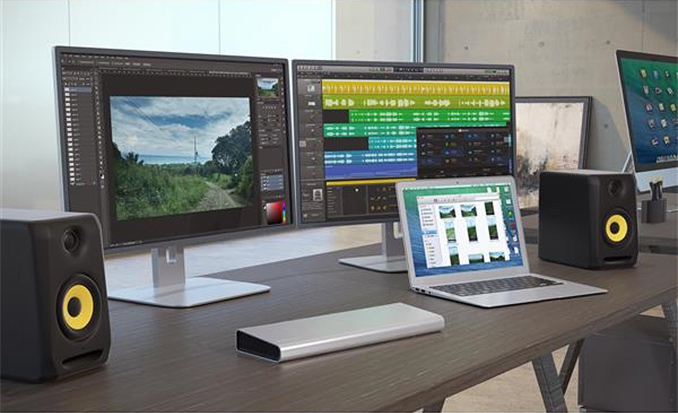



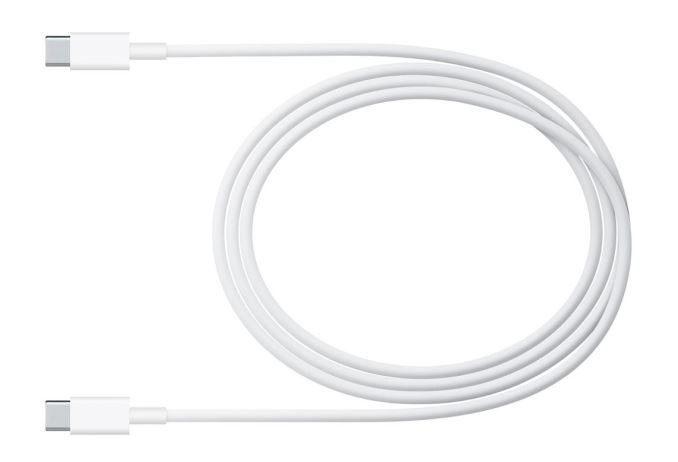
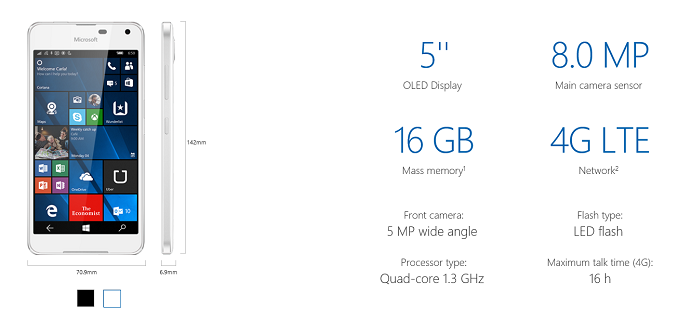

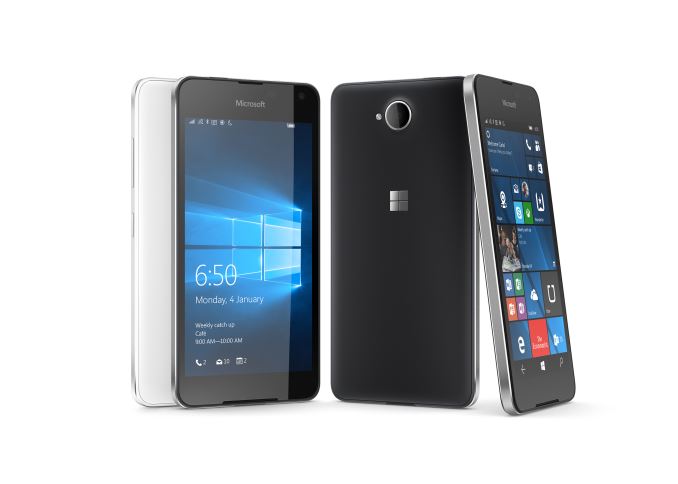

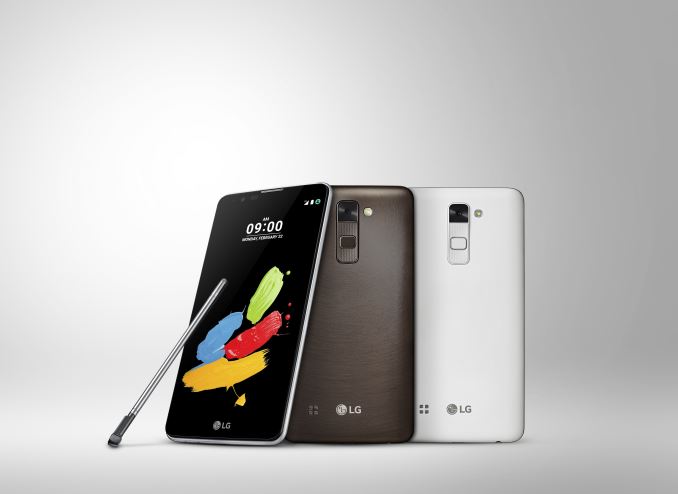

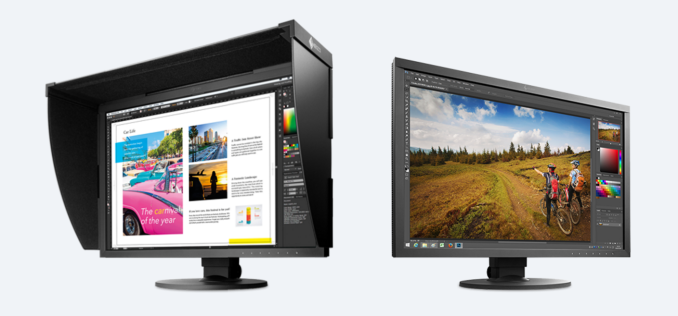
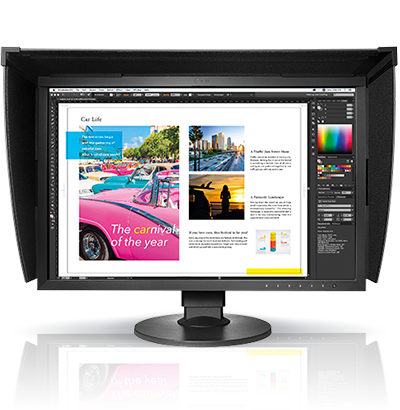
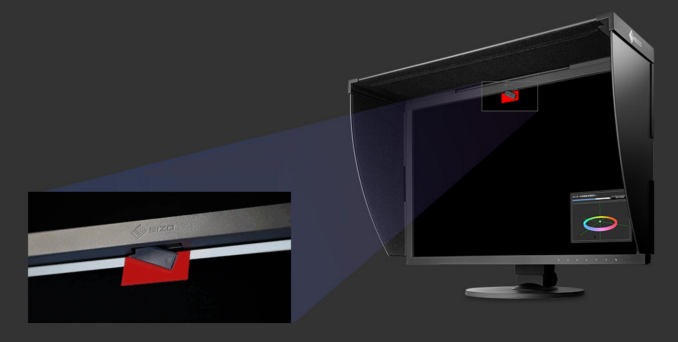

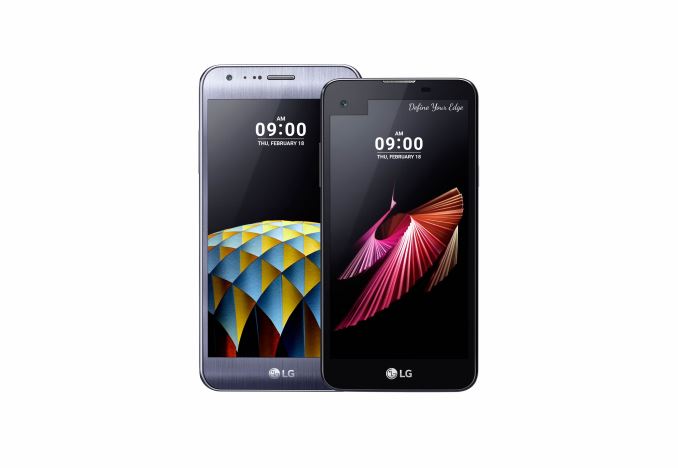



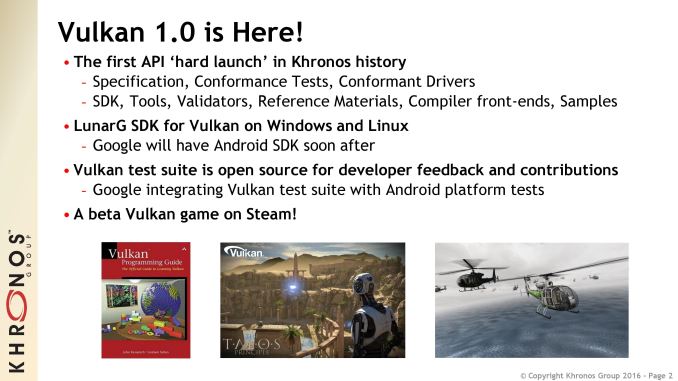

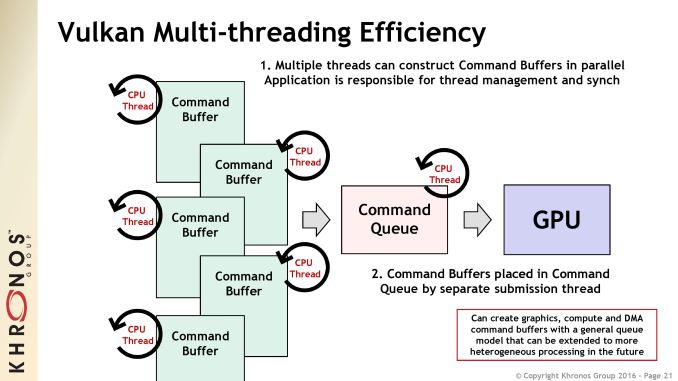
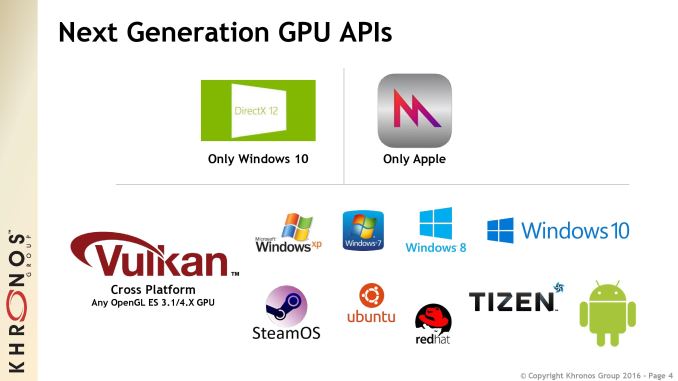
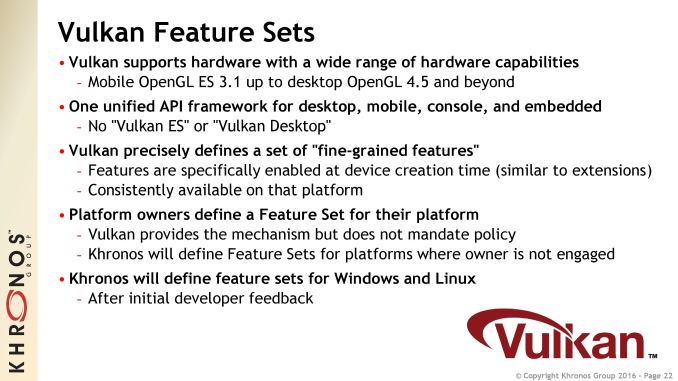
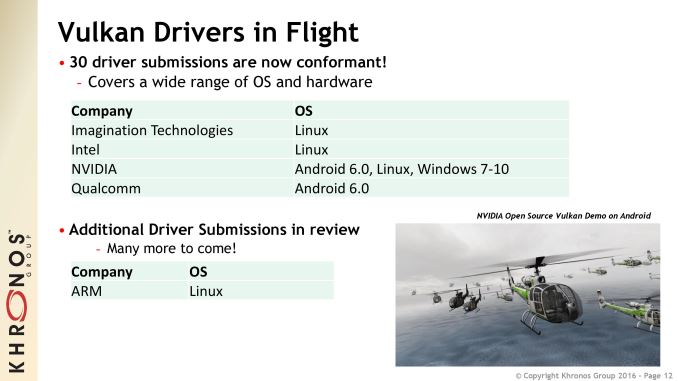

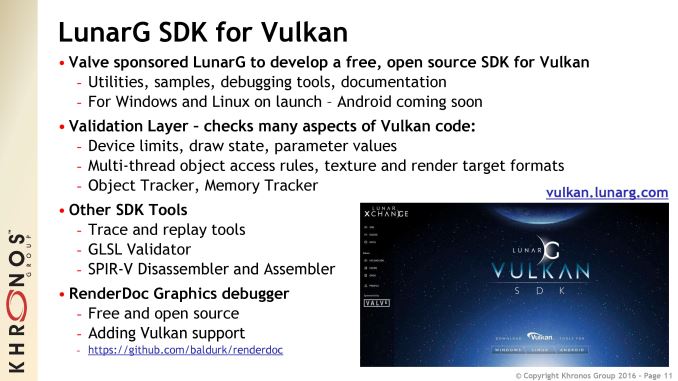
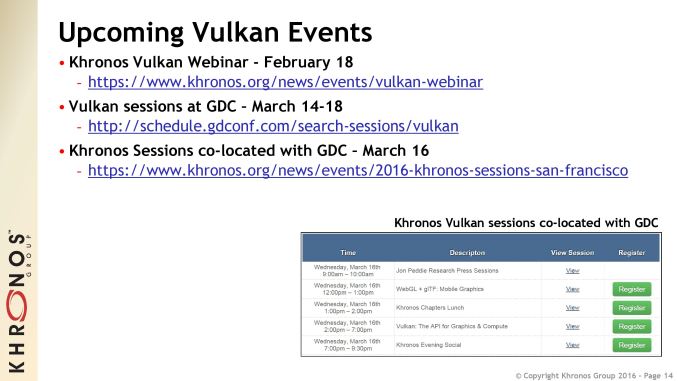






















Bookmarks